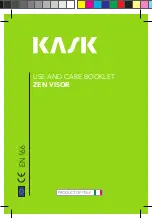
TrinityHighway.com
29
Created November 2021
Delineation
The state/specifying agency will establish the criteria for delineation of the line posts. The
delineation is typically provided on the spacer used to separate the cables.
It is suggested for the terminal CRP that reflective sheeting (PN- 5851 or PN-5851) be affixed to
delineate them, which could help to reduce some impacts. Trinity Highway makes no guarantees
they meet the minimum specifications, comply with MUTCD requirements or comply with
state/specifying agency requirements. It is recommended that all of the CRPs be delineated.
Repairs
After an impact, the system will require repair. Full scale crash testing conducted in conformance
with NCHRP Report 350 indicates that the cable will typically remain close to its original height
depending on the number of posts damaged. It is recommended that the system be repaired as
soon as possible by the appropriate state/specifying agency.
After most impacts, the system can be repaired in a relatively short period of time. Any part(s)
which visually appears damaged must be replaced. Additional specific parts of CASS
®
S4(29),
which must be replaced in order to bring the system back into full service, is a decision that must
be made by the appropriate state/specifying agency.
An impact that encounters a CCT may require re-tensioning of the entire run of cable. After
repairing the cable, the tension throughout the system should be checked.
It is recommended that for impacts outside of the testing parameters that the cable be checked
to determine if re-tensioning is required.
Important:
Trinity Highway makes no recommendation whether use or reuse
of any part of the system is appropriate or acceptable following an impact. It
is the sole responsibility of the state/specifying agency and its engineers or it
agent to make that determination. It is critical that you inspect this product
after assembly is complete to make certain that the instructions provided in
this manual have been strictly followed.
Repair for CASS
®
S4(29) Impact (CRP Not Impacted)
If an impact occurs and a CCT CRP is not involved, usually only the line or terminal posts will
have to be replaced and the cables re-inserted in the posts or attached to the post. Follow the
steps below in making this repair:
1. Inspect the damaged system and determine what components will be required to correct
and repair CASS
®
S4(29) to originally specified working condition.
2. Remove the damaged posts. During very cold weather and in Northern climates, the post
may become frozen into the socket. Successful means of extraction have utilized propane
torches or a hammer drill to break-up the ice. With approval from the state/specifying
agency, calcium chloride (a common deicing chemical) can also be mounded over the top
of the ice for 24 hours prior to removal of the post. As always, wear appropriate safety
equipment such as work gloves and eye protection during post removal. If the posts are
driven, they will have to be pulled out of the ground.
3. Replace any damaged posts.
4. Replace the cables. For the line cables, see the “
Laying Out the Cable/Attaching the
Cables to the Post”
section. For the CCT cables, see the
“Terminal Cables”
section.
Depending on the severity of the impact, after the repair, the cable may need to be re-tensioned.
Trinity Highway recommends the tension of the cable be checked with the tension meter and
adjustments made at the turnbuckles to bring the cable to the correct tension based on the cable
temperature values on the CASS
®
S4(29) System Temperature/Tension chart. See the
“Tensioning and Tension
Meter”
section to make any tension adjustments.
Содержание TRINITI HIGHWAY CASS S4
Страница 1: ......
Страница 38: ...TrinityHighway com 37 Created November 2021 Appendix A Flare Assemblies 30 1 Flare...
Страница 39: ...TrinityHighway com 38 Created November 2021 Appendix B Cable Barrier Overlap...
Страница 42: ......













































